
Naive Art -II
Outsider art
Jean Dubuffet
1901 – 1985

Jean Philippe Arthur Dubuffet
(31 July 1901 – 12 May 1985) was a French painter and sculptor. His idealistic approach to aesthetics embraced so-called "low art" and eschewed traditional standards of beauty in favor of what he believed to be a more authentic and humanistic approach to image-making. He is perhaps best known for founding the art movement art brut, and for the collection of works—Collection de l'art brut—that this movement spawned. Dubuffet enjoyed a prolific art career, both in France and in America, and was featured in many exhibitions throughout his lifetime.
Dubuffet was born in Le Havre to a family of wholesale wine merchants who were part of the wealthy bourgeoisie. His childhood friends included the writers Raymond Queneau and Georges Limbour. He moved to Paris in 1918 to study painting at the Académie Julian, becoming close friends with the artists Juan Gris, André Masson, and Fernand Léger. Six months later, upon finding academic training to be distasteful, he left the Académie to study independently. During this time, Dubuffet developed many other interests, including free noise music, poetry, and the study of ancient and modern languages. Dubuffet also traveled to Italy and Brazil, and upon returning to Le Havre in 1925, he married for the first time and went on to start a small wine business in Paris. He took up painting again in 1934 when he made a large series of portraits in which he emphasized the vogues in art history. But again he stopped, developing his wine business at Bercy during the German Occupation of France. Years later, in an autobiographical text, he boasted about having made substantial profits by supplying wine to the Wehrmacht.

JEAN DUBUFFET: A View of Paris with Furtive Pedestrians, 1944

Jean Dubuffet, View of Paris, The Life of Pleasure, 1944

View of Paris, small business
Jean Dubuffet
1944

JEAN DUBUFFET: ARCHETYPES, 1945|

JEAN DUBUFFET: METAFIZYX. 1950.

JEAN DUBUFFET: DREAM CRYSTALLIZATION. 1952

JEAN DUBUFFET: BUSTLING LIFE. 1953. Paris. Fondation Dubuffet

Jean Dubuffet
The Exemplary Life of the Soil (Texturology LXIII)
1958

Jean Dubuffet
Man with a Hod
1955–6

Jean Dubuffet
Spinning Round
1961

JEAN DUBUFFET - COUCOU BAZAR

JEAN DUBUFFET - COUCOU BAZAR

JEAN DUBUFFET - COUCOU BAZAR

JEAN DUBUFFET
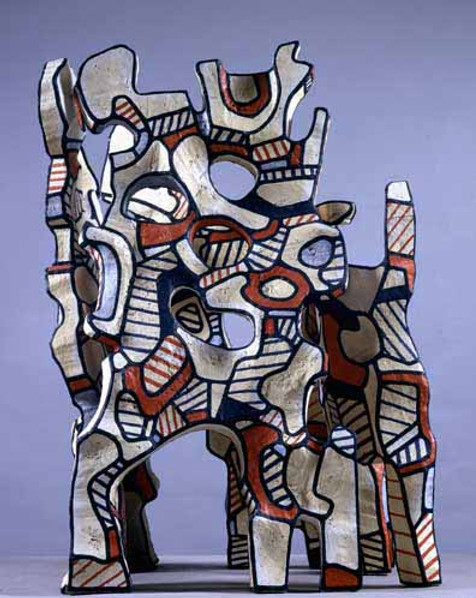
JEAN DUBUFFET

JEAN DUBUFFET

JEAN DUBUFFET
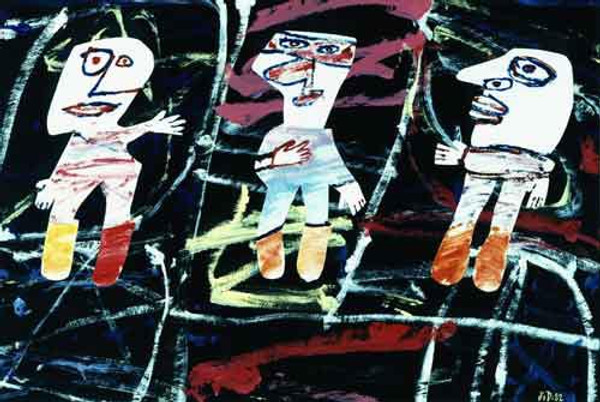
JEAN DUBUFFET
Ludovit Fulla
1902 – 1980

Ludovit Fulla
(27 February 1902, Ružomberok – 21 April 1980, Bratislava) was a Slovak painter, graphic artist, illustrator, stage designer and art teacher. He is considered one of the most important figures of Slovak creative art in the 20th century.
Fulla's work was fundamentally important for the establishment of Slovak modernism. His personal style is characterized by a special "poetry of the image" relying on surface and decoration, a synthesis of rational and emotional elements, brilliant colour, knowledge of folk art, East Slavonic iconography and world Modernism. Ľudovít Fulla was predominantly inspired by the Prague modernist milieu. In his works, the principles of Wassily Kandinsky, Marc Chagall, Pablo Picasso and Paul Klee can be found. In the only manifesto of Slovak modernists, he and his friend Mikuláš Galanda formulated a firm stance in their attempt of a mixture of styles. Fulla was recognised for generations for his bright red, orange and yellow. This may have played off the folk iconography always present in his works, or may have been a further admixture of artistic period styles.
Ľudovít Fulla

Ľudovít Fulla

Ľudovít Fulla

Ľudovít Fulla

Ľudovít Fulla
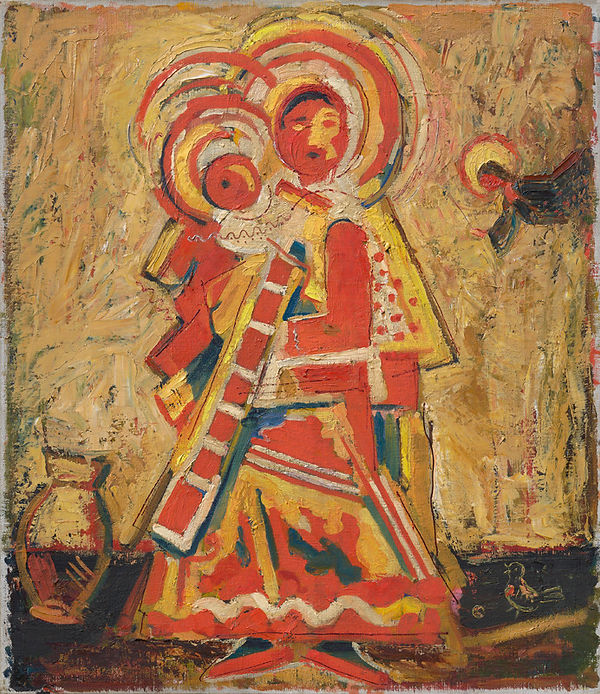
Ľudovít Fulla

Ľudovít Fulla

Ľudovít Fulla

Ľudovít Fulla

Ľudovít Fulla

Ľudovít Fulla

Ľudovít Fulla

Ľudovít Fulla

Ľudovít Fulla

Ľudovít Fulla

Ľudovít Fulla

Ľudovít Fulla

Ľudovít Fulla

Ľudovít Fulla

Ľudovít Fulla

Ľudovít Fulla

Ľudovít Fulla
Josef Wittlich
1903 - 1982
Josef Wittlich
born February 26, 1903 in Gladbach (de) and died September 21, 1982 in Höhr-Grenzhausen, is a German painter and draftsman of outsider art.
Son of a button maker, Josef Wittlich grew up in a poor family. He lost his mother at the age of four and found himself exposed to the brutality of his father and the hostility of his stepmother. After a basic education, he joined the foreign legion then worked for a few years as an orderly for an officer in Paris1. In the late 1920s, he traveled through Eastern Europe and the Balkans. In 1934, he was an agricultural worker in Nauort2. It was there that he began to paint, mainly scenes from the First World War. From this time, he used shimmering colors which he applied in flat areas and surrounded by a black circle3.
Enlisted during the Second World War, he was sent to a munitions factory in Kassel in 1942. Taken prisoner by the Russians, he was released at the end of the war and settled in Höhr-Grenzhausen where he found employment in the Steuler ceramic factory in 1948. From 1957, he returned to drawing and painting1. Inspired by magazine photos, his works mainly address three themes: soldiers and war scenes, portraits of royal families or celebrities and portraits of women. In 1967, his images were discovered by the painter Fred Stelzig while visiting the ceramic factory where Wittlich was authorized to hang some of his paintings4. The same year, Stelzig organized his first exhibition at the Württembuerrgischer Kunstverein in Stuttgart5. Josef Wittlich retired in 1968 as a new phase of his life began in which he could devote himself exclusively to painting. Considered by Meinrad Maria Grewenig as a precursor of Pop Art, his works have since been exhibited around the world6.



Josef Wittlich

Josef Wittlich

Josef Wittlich

Josef Wittlich

Josef Wittlich

Josef Wittlich

Josef Wittlich

Josef Wittlich

Josef Wittlich

Josef Wittlich

Josef Wittlich

Josef Wittlich

Josef Wittlich

Josef Wittlich
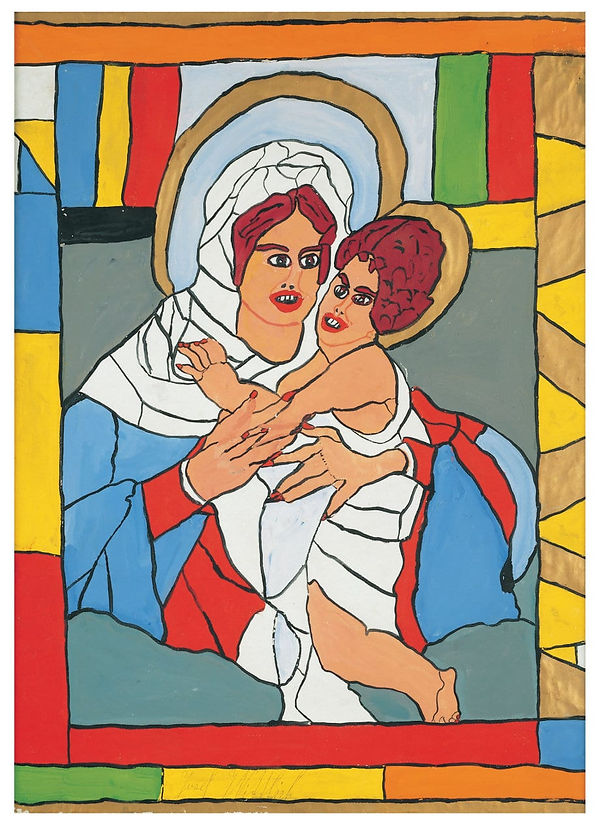
Josef Wittlich

Josef Wittlich

Josef Wittlich

Josef Wittlich

Josef Wittlich

Josef Wittlich

Josef Wittlich

Josef Wittlich

Josef Wittlich

Josef Wittlich

Josef Wittlich
Maxwell Bates
1906 – 1980

Maxwell Bates
(14 December 1906 – 14 September 1980) was an architect and expressionist painter.
Born in Calgary, Alberta in 1906, Bates started painting at an early age; his piece In the Kitchen was painted when he was 15 years old. As a young adult, he worked for his father's architecture firm. His father, William Stanley Bates, was himself a prominent architect in early Calgary who designed the Burns Building (1912) and the Grain Exchange (1909).
Bates studied with Lars Jonson Haukaness at the Provincial Institute of Technology and Art in Calgary from 1926–1927. In 1931 Bates moved to England, where he supported himself as a door-to-door vacuum salesman while exhibiting his art work at the Wertheim Gallery. In England he associated with promising young artists such as Barbara Hepworth and Victor Pasmore.
As a member of the British Territorial Army in 1940, Bates was captured in France and became a prisoner of war in Thuringia. He remained a POW until 1945. This experience was captured in his 1978 book A Wilderness of Days.
Bates returned to Calgary in 1946 to work with his father's architectural firm again. His first wife May Watson, whom he married in 1949, died in 1952. He then married Charlotte Kintzle in 1954.
In 1949 Bates studied at the Brooklyn Museum with artist Max Beckmann and Abraham Rattner. As an architect, his most notable work was St. Mary's Cathedral, which was consecrated in 1957.
Bates suffered a stroke in 1961. In 1962 he moved from Calgary to Victoria, British Columbia. He suffered a second stroke in 1978 and died in Victoria in 1980.

Maxwell Bates
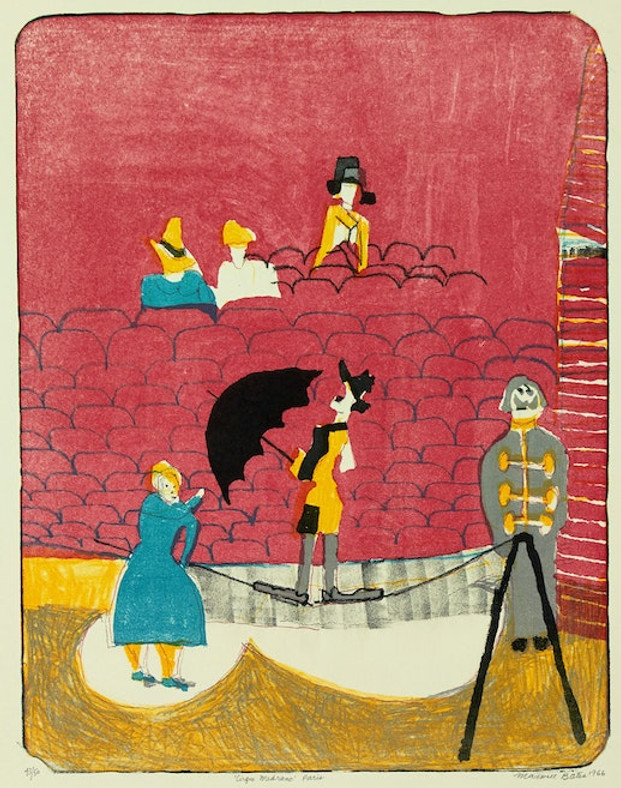
Maxwell Bates

Maxwell Bates

Maxwell Bates
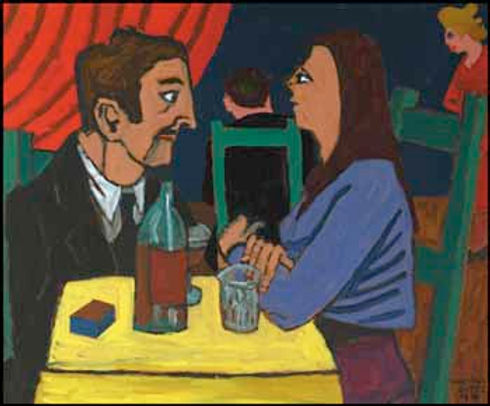
Maxwell Bates

Maxwell Bates

Maxwell Bates

Maxwell Bates

Maxwell Bates

Maxwell Bates

Maxwell Bates

Maxwell Bates

Maxwell Bates

Maxwell Bates

Maxwell Bates

Maxwell Bates

Maxwell Bates

Maxwell Bates

Maxwell Bates

Maxwell Bates

Maxwell Bates
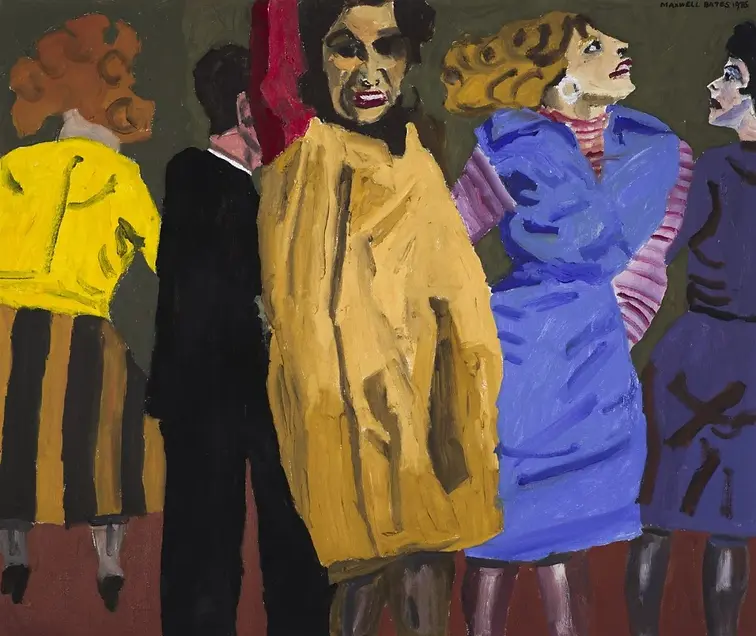
Maxwell Bates

Maxwell Bates

Maxwell Bates
Jessie Oonark
1906 – 1985
Jessie Oonark
(2 March 1906 – 7 March 1985) was a prolific and influential Inuit artist of the Utkuhihalingmiut Utkuhiksalingmiut whose wall hangings, prints and drawings are in major collections including the National Gallery of Canada.
She was born in 1906 in the Chantrey Inlet (Tariunnuaq) area, near the estuary of the Back River in the Keewatin District of the Northwest Territories (now Nunavut)—the traditional lands of the Utkukhalingmiut Utkukhalingmiut, Utkukhalingmiut (the people of the place where there is soapstone). Her artwork portrays aspects of the traditional hunter-nomadic life that she lived for over five decades, moving from fishing the camp near the mouth of Back River on Chantrey Inlet in the Honoraru: 3 area to their caribou hunting camp in the Garry Lake area, living in winter snow houses (igloos) and caribou skin tents in the summer. Oonark learned early how to prepare skins and sew caribou skin clothing. They subsisted mainly on trout (lake trout and Arctic char), whitefish, and barren-ground caribou. The knife used by women, the ulu, their traditional skin clothing, the kamik, the amauti were recurring themes in her work. Oonark has had a major museum retrospective with accompanying scholarly monograph. Despite a late start – she was 54 years old when her work was first published – she was an active and prolific artist over the next 19 years, creating a body of work that won critical acclaim and made her one of Canada's best known Inuit artists.

Jessie Oonark

Jessie Oonark

Jessie Oonark

Jessie Oonark

Jessie Oonark

Jessie Oonark

Jessie Oonark

Jessie Oonark

Jessie Oonark

Jessie Oonark

Jessie Oonark

Jessie Oonark

Jessie Oonark

Jessie Oonark
Julian Trevelyan
1910 – 1988
Julian Otto Trevelyan
(20 February 1910 – 12 July 1988) was an English artist and poet.
Trevelyan was the only child to survive to adulthood of Robert Calverley Trevelyan and his wife Elizabeth van der Hoeven. His grandfather was the liberal politician Sir George Trevelyan, 2nd Baronet, and his uncle the historian George Macaulay Trevelyan; he is the great-uncle of his namesake, Julian Trevelyan the pianist.
Julian Trevelyan was educated at Bedales School and Trinity College, Cambridge, where he read English Literature.
He moved to Paris to become an artist, enrolling at Atelier Dix-Sept, Stanley William Hayter's engraving school, where he learned etching. He worked alongside artists including Max Ernst, Oskar Kokoschka, Joan Miró and Pablo Picasso.
In 1935, Trevelyan bought Durham Wharf, beside the river Thames in Hammersmith, London. This became his home and studio for the rest of his life and was a source of artistic inspiration to him. He became a confirmed Surrealist and exhibited at the International Surrealist Exhibition, held at the New Burlington Galleries in London.
From 1950 to 1955, Trevelyan taught history of art and etching at the Chelsea School of Art.
From 1955 to 1963, Trevelyan worked at the Royal College of Art and became Head of the Etching Department. Because of his enthusiasm in his work and the desire to share it with others, Trevelyan became a highly influential teacher, with students including David Hockney, Ron Kitaj and Norman Ackroyd. He was an important leader of modern print techniques and today is regarded as a silent driving force behind the etching revolution of the 1960s.
In 1969, he produced the Thames Suite, a collection of 12 views of the Thames from its upper reaches in Oxford and Henley-on-Thames down to the tidal stretches of London and the Estuary.

Julian Trevelyan

Julian Trevelyan

Julian Trevelyan

Julian Trevelyan

Julian Trevelyan

Julian Trevelyan

Julian Trevelyan

Julian Trevelyan

Julian Trevelyan

Julian Trevelyan

Julian Trevelyan

Julian Trevelyan

Julian Trevelyan

Julian Trevelyan

Julian Trevelyan

Julian Trevelyan

Julian Trevelyan

Julian Trevelyan
Ivan Generalic
1914 – 1992
Ivan Generalic
(December 21, 1914 – November 27, 1992) was a Croatian painter in the naïve tradition.
Generalić was born in Hlebine near Koprivnica. In elementary school, painting lessons were his greatest joy and as a child he used to earn money. He mostly drew with pencil on paper bags and some of these sketches were seen by Krsto Hegedušić, at the time (1930) just a student of the art academy, later a professor. Hegedušić was impressed with Generalić's work and organized Generalić's first public art exhibition, held in 1931 in the Zagreb Art pavilion. Positive critiques and contacts at the time led to a new era of not only Croatian, but also world art as well.
After World War II, in 1945 he became a member of ULUH (society of Croatian artists). In 1953 he exhibited in Paris, where he lived and painted for a few months. In 1959 he painted The Deer Wedding - his most valuable work, according to followers of the Croatian naïve art world. His home and peasant life of that time was his inspiration. His subjects include weddings, farm work, seasonal celebrations and funeral processions, and his rural scenes often included political commentaries on the social injustices of his time. Due to his technique of using oil paints on the reverse of a glass pane rather than conventional canvas, his pictures have a unique reflective quality.

Ivan Generalić
Self Portrait
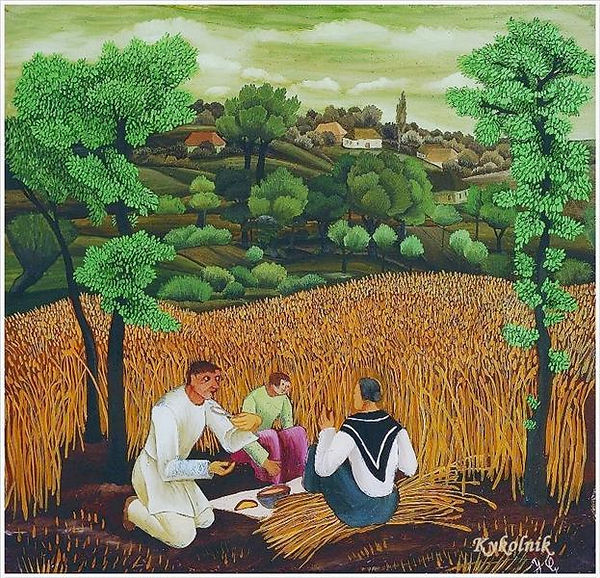
Ivan Generalić

Ivan Generalić

Ivan Generalić

Ivan Generalić

Ivan Generalić

Ivan Generalić

Ivan Generalić

Ivan Generalić

Ivan Generalić

Ivan Generalić

Ivan Generalić

Ivan Generalić

Ivan Generalić

Ivan Generalić

Ivan Generalić

Ivan Generalić

Ivan Generalić

Ivan Generalić

Ivan Generalić

Ivan Generalić

Ivan Generalić

Ivan Generalić

Ivan Generalić

Ivan Generalić

Ivan Generalić

Ivan Generalić
Howard Finster
1916 – 2001

Howard Finster
(December 2, 1916 – October 22, 2001) was an American artist and Baptist minister from Georgia. He claimed to be inspired by God to spread the gospel through the design of his swampy land into Paradise Garden, a folk art sculpture garden with over 46,000 pieces of art. His creations include outsider art, naïve art, and visionary art. Finster came to widespread notice in the 1980s with his album cover designs for R.E.M. and Talking Heads.
Finster was born at Valley Head, Alabama, to Samuel and Lula Finster, and lived on the family farm as one of 13 children. He attended school from age six into the sixth grade. He said he had his first vision at the age of three years, when he saw his recently deceased sister Abbie Rose walking down out of the sky wearing a white gown. She told him, "Howard, you're gonna be a man of visions."
He became "born again" at a Baptist revival at the age of 13 and began to preach at 16. He gave the occasional sermon at local churches and wrote articles for the town newspaper, and became a full-time pastor at Rock Bridge Baptist Church in 1940. He later served at the Mount Carmel Baptist Church in Fort Payne, Alabama, shortly before venturing into full-time art.
Howard Finster

Elvis And The Arpitaun World
Howard Finster
1980

American Devils Are Friendly
Howard Finster
1981

The Super Powers (4581)
Howard Finster

Angel Gabriel
Howard Finster

The Great Cheetah
Howard Finster

Baby Elvis
Howard Finster

Self-Portrait 1937, #11,769
Howard Finster

Baby's Angel
Howard Finster

City of Sirloc
Howard Finster

Desert Taxi
Howard Finster

Holy Child of Bethlehem (Kid's Dream World)
Howard Finster
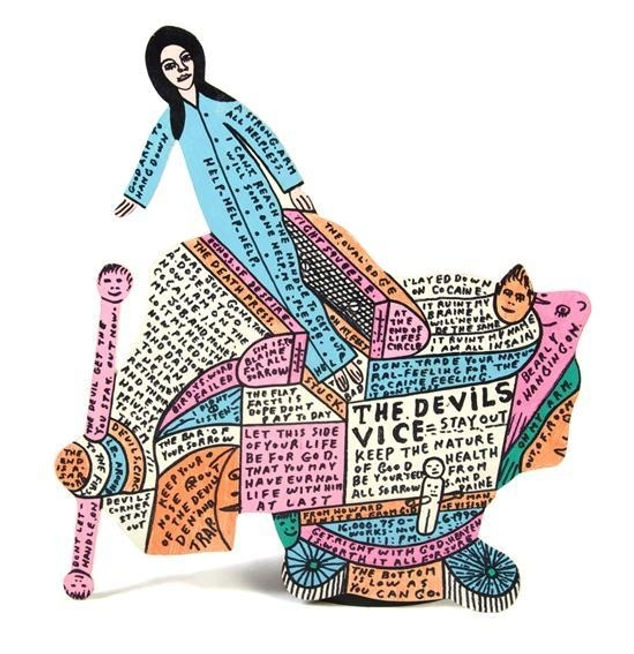
The Devil's Vice
Howard Finster

Cow Lady
Howard Finster

Frog
Howard Finster

Angel Baby with Coca Cola
Howard Finster